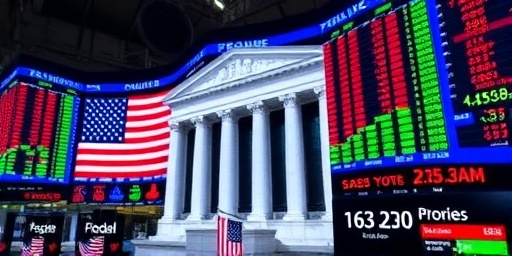In a stunning display of market confidence, US stocks rallied sharply on Wednesday, propelling the S&P 500 and Nasdaq Composite to all-time highs. The surge was ignited by Federal Reserve Chair Jerome Powell’s dovish comments during a speech in Dallas, where he suggested a Fed rate cut in December is increasingly likely as inflation continues to moderate. Investors, buoyed by signs of economic resilience, poured into equities, with tech giants like Apple, Microsoft, and Nvidia leading the charge in a broad-based stock market rally.
The S&P 500 climbed 1.2% to close at 5,987.45, marking its fourth record in five days, while the Nasdaq soared 1.8% to 18,654.32. The Dow Jones Industrial Average, though more subdued, added 0.8% to end at 43,210.89. This latest milestone comes amid a backdrop of cooling inflation pressures, with the latest Consumer Price Index (CPI) data showing annual inflation at 2.4% in October, down from 2.6% the previous month and edging closer to the Fed’s 2% target.
Powell’s Dovish Pivot Fuels Investor Euphoria
Federal Reserve Chair Jerome Powell’s remarks served as the catalyst for the day’s exuberance. Speaking at the Dallas Fed’s annual economic summit, Powell emphasized that recent data points to a ‘disinflationary process’ gaining traction. ‘We are well positioned to consider a rate cut in December if incoming data continues to support our view of sustained progress toward price stability,’ he stated, according to transcripts released by the central bank. This subtle shift from earlier hawkish tones has Wall Street abuzz, interpreting it as a green light for monetary easing after a series of aggressive hikes that peaked at 5.25-5.50% earlier this year.
Analysts at Goldman Sachs were quick to highlight the implications. ‘Powell’s comments align with our base case for a 25-basis-point Fed rate cut in December, potentially followed by more in 2025,’ wrote strategist David Kostin in a note to clients. The prospect of lower borrowing costs has reignited hopes for sustained corporate earnings growth, particularly in interest-rate-sensitive sectors like real estate and consumer discretionary. Bond yields reacted swiftly, with the 10-year Treasury note dipping to 4.15%, its lowest in over a month, further amplifying the bullish sentiment.
Contextually, the Fed’s pivot is rooted in a robust yet balanced economic picture. Third-quarter GDP growth came in at 2.8%, surpassing expectations, driven by strong consumer spending and business investment. Unemployment remains low at 4.1%, and wage growth has stabilized without reigniting inflationary fears. These factors have convinced policymakers that the economy can handle a Fed rate cut without overheating, a view echoed by Powell: ‘The labor market is cooling but not collapsing, and that’s exactly what we want to see.’
Tech Titans Drive Nasdaq’s Record-Breaking Climb
The stock market rally was overwhelmingly powered by the technology sector, which has become synonymous with market highs in 2024. The Nasdaq’s 1.8% gain was its strongest since September, propelled by a trio of megacaps: Nvidia surged 2.5% to $142.83, buoyed by fresh AI demand forecasts; Apple rose 1.9% to $235.45 on reports of robust iPhone 16 sales; and Microsoft advanced 1.7% to $418.22 amid cloud computing revenue beats. The ‘Magnificent Seven’—which also includes Amazon, Alphabet, Meta, and Tesla—collectively added over $300 billion in market value in a single session.
Broader tech indices told a similar story. The semiconductor-heavy Philadelphia Semiconductor Index jumped 2.3%, with Advanced Micro Devices (AMD) and Broadcom leading gains after positive analyst upgrades. Investors are betting that lower interest rates will accelerate capital expenditures on AI infrastructure, a narrative that has sustained the sector’s dominance. ‘Tech’s resilience in the face of higher rates has been impressive, but a Fed rate cut could unlock even more upside,’ noted Wedbush Securities analyst Dan Ives in an interview with CNBC.
However, not all tech was created equal. Smaller-cap tech firms, often more leveraged to economic cycles, saw more modest gains, underscoring the rally’s concentration in established leaders. The Russell 2000, a proxy for small caps, lagged with a 0.5% increase, highlighting ongoing disparities in market breadth. Still, the sector’s performance underscores optimism over economic resilience, with corporate America reporting fewer layoffs and steady innovation pipelines.
Looking at historical parallels, the current S&P 500 trajectory mirrors the post-2018 rate cut cycle, where the index rose over 30% in the following year. Data from Bloomberg shows that Fed easing signals have historically preceded average gains of 15% for the Nasdaq within six months, fueling speculation of more records ahead.
Inflation Data Bolsters Case for Monetary Easing
At the heart of the Fed rate cut speculation lies the ongoing battle against inflation. The Bureau of Labor Statistics reported that core CPI, excluding volatile food and energy, rose just 0.2% month-over-month in October, translating to a 3.2% annual rate—below forecasts and the slowest since early 2021. Shelter costs, a stubborn component, finally showed signs of deceleration, dropping to 4.9% year-over-year, while energy prices fell 2.1% amid stable global supplies.
Economists attribute this progress to the Fed’s 11 rate hikes since 2022, which have successfully tamed demand without tipping the economy into recession. ‘Inflation is not dead, but it’s on life support,’ quipped JPMorgan chief economist Bruce Kasman during a panel discussion. Producer Price Index (PPI) figures released earlier in the week corroborated the trend, with wholesale inflation at 1.8% annually, signaling easing pressures further up the supply chain.
Yet, challenges persist. Geopolitical tensions in the Middle East could spike oil prices, and potential tariff hikes under a new administration add uncertainty. The Fed’s preferred gauge, the Personal Consumption Expenditures (PCE) index, is due next week and could solidify the case for a December move. If it mirrors CPI’s softness, markets may price in even more aggressive cuts, with futures now showing a 92% probability of easing next month, up from 75% pre-Powell.
Consumer sentiment surveys reflect this cooling inflation environment. The University of Michigan’s index climbed to 72.5 in November’s preliminary reading, with one-year inflation expectations dipping to 3.0%. This psychological shift is crucial, as it encourages spending and investment, key drivers of the stock market rally.
Broader Market Sectors Join the Upward Momentum
Beyond tech, the S&P 500‘s advance drew participation from diverse corners. Financials gained 1.1%, with banks like JPMorgan Chase and Bank of America rising on expectations of narrower net interest margins post-rate cuts but higher loan volumes. Consumer staples, often defensive, added 0.9%, led by Procter & Gamble’s steady earnings outlook.
Energy stocks bucked the trend slightly, falling 0.3% as oil prices softened to $78 per barrel for WTI crude, but overall market breadth improved with 85% of S&P 500 components closing higher. Real estate investment trusts (REITs) soared 2.4%, the best performer, as lower rates promise cheaper refinancing and higher property values. Vanguard’s REIT ETF (VNQ) hit a 52-week high, reflecting sector-wide relief.
International markets also perked up. Europe’s Stoxx 600 rose 0.7%, while Asia’s Nikkei 225 gained 1.2% in sympathy trading. Currency markets saw the US dollar weaken 0.4% against a basket of majors, benefiting exporters. Volatility, as measured by the VIX, plunged to 14.2, its lowest in months, signaling diminished fear.
Trading volume spiked to 11.2 billion shares, above the 30-day average, indicating genuine conviction rather than thin speculation. Options activity showed heavy call buying in tech names, with implied volatility for the S&P 500 year-end target now centered around 6,200—a 3.5% upside from current levels.
Looking Ahead: Rate Cut Path and Economic Roadblocks
As the dust settles on this stock market rally, eyes turn to the Fed’s November meeting minutes, due Thursday, for deeper insights into policymakers’ thinking. A December Fed rate cut now seems all but assured, but the pace beyond that remains debated. Some officials, like Atlanta Fed President Raphael Bostic, advocate caution, warning of persistent services inflation, while others push for 75 basis points of easing by mid-2025.
Corporate earnings season ramps up next week, with Delta Air Lines and Walmart set to report, offering fresh clues on consumer health. If results affirm resilience, the S&P 500 could test 6,000 by year-end, per UBS forecasts. However, risks loom: escalating trade wars or a surprise inflation rebound could prompt a Fed rethink, potentially curbing the rally.
Investors are advised to diversify amid this optimism. ‘While the setup is positive, valuations are stretched—the S&P 500‘s forward P/E is at 22x, above historical norms,’ cautioned BlackRock’s Rick Rieder. Still, with economic resilience intact and monetary policy turning supportive, the path of least resistance appears upward, setting the stage for a potentially merry market close to 2024.









